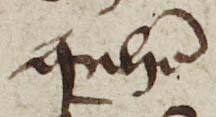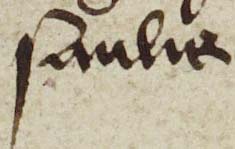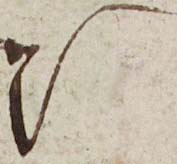|
| A |
 | Usage: art
headless 'a' with fine joining stroke to complete. |  | Usage: was
a square-shaped lobe for the single compartment. |
 | Usage: lady
the fine head-line is not always visible or may not join the two down-strokes, as here. |  | Usage: And
upper case 'A' with the top of 'H' on the line below tangling with the graph at the right of the loop at the bottom of the image. |
|
| D |
 | Usage: goddis
looped 'd' with lower compartment angular or rounded. |  | Usage: doth
a squat version with the lower arm of the upper loop lying almost horizontal. |
 | Usage: lord
tagged 'd' in final position. |  | Usage: mod(er)
'd' with abbreviation for 'er' arching above the graph. |
|
| G |
 | Usage: gy
the body of the graph is formed like a modern 'c' with an 'f'-shaped stroke with curved head beginning above the graph, descending vertically below the level of the body, turning clockwise almost at right angles and finally rejoining the body of the graph. |  | Usage: goddis |
 | Usage: thing(es)
the f-shaped stroke is suppressed and horizontal dash from the head loops round and down to form the 'es' abbreviation. |  | Usage: king
the tail-stroke loops back to cross the head of the graph. |
|
| H |
 | Usage: helle
looped head, short limb and tail-stroke which turns clockwise and tucks away neatly beneath the graph. |  | Usage: caucht |
 | Usage: quhe(n) |  | Usage: Erthe
'h' is often crossed when it follows 't'. |
|
| R |
 | Usage: ran
'z'-shaped 'r' or some variation of it is used throughout. |  | Usage: flour
final 'r' with flourish perhaps indicative of missing 'e'. |
 | Usage: quharfor |  | Usage: Reme(m)br(e) |
|
| S |
 | Usage: schapin
long 's' is used in initial and medial positions. |  | Usage: goddis
a rather fragmented form of 's' which is always used in final position. |
 | Usage: c(ri)stin
it is often difficult to distinguish between 'st' and 'sc'. |  | Usage: saulis
long 's' begins the word with tapering down-stroke and separate head-stroke. The odd-shaped 's' is used in final position. |
|
| W |
 | Usage: a wait
'w' occurs in at least two different forms. Here a looped left limb is followed by a six-shaped element to finish. |  | Usage: way
a cursive form of the same letter. Most of the scribe's 'w's follow this pattern. |
 | Usage: sorow
a smoother version of the first example. |  | Usage: Weill
an upper case version of the second example completed in cursive fashion. |
|
| Y |
 | Usage: m(er)cy
'y' frequently has a long tail which bows slightly as it descends. |  | Usage: dyrne
this version of the scribe's 'y' is difficult to distinguish from his thorn. |
 | Usage: lady
a more angular version of the first example. The The 'v'-shape which forms the body of the graph does not have contact with the tail in its descent. |  | Usage: gy
the final word in the line with exhuberant continuation of the tail into the right margin. |
|
| Thorn |
 | Usage: þin
the scribe's thorns are difficult to distinguish from the 'y' graph as seen in version 2 of 'y'. |  | Usage: þis |
 | Usage: þat
this thorn is like the more usual form of the scribe's 'y' and it is possible that the scribe himself had not settled on a distinction between the two graphs. |  | Usage: Þou |
|
| ce and te |
 | Usage: ordinaunce
'c' is an odd-shaped graph which resembles an angle bracket. Its descent below the level of surrounding graphs is disconcerting. |  | Usage: rame(m)beraunce
'e' is also an awkward graph to read in this hand. In the middle of words it may resemble the 'a' which I believe is the second letter in this word where one would expect an 'e'. In final position, 'e' has scooped head which curves up slightly and extends away from the body of the graph. |
 | Usage: humilite
it is sometimes difficult to distinguish between 't' and 'c'. The 't' here looks very much like the 'c' in the previous example. |  | Usage: subtilite
't' does tend to be more upright with no angle in the middle. |
|
| n and m |
 | Usage: schapin
in final position, the second minim of 'n' is lengthened. |  | Usage: ente(n)cioun
sometimes the final stroke of 'n' follows a clockwise trajectory and almost becomes a complete circle surrounding several graphs. This word is extremely difficult to read! |
 | Usage: ou(er)cum
the unusual formation of 'c' is clear in this example as is the length of the final minim of 'm'. |  | Usage: mod(er)
'm' in initial position with curved approach stroke. |














































